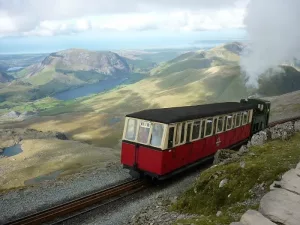Manual or Automatic Motorhomes
A key question when buying a motorhome or campervan is whether to buy an automatic motorhome or a manual motorhome. A motorhome is a huge investment. Decisions are already coming thick and fast, without this one too! Driving your motorhome is going to be a regular occurrence once purchased!
Let’s take some time to look at the two options to try and help you decide which one you should buy. You can jump straight to our top ten FAQ’s on choosing between an automatic or manual transmission motorhome if you prefer.
Manual or Automatic Motorhomes - Go To...
Should you Buy an Automatic Motorhome?
I have experience of driving an automatic motorhome in New Zealand and a manual motorhome everywhere else. An automatic is a much more chilled out experience. They really are great. If you are seriously thinking of buying one I would recommend hiring one for a long weekend. A lot of money is being invested in the beautiful new vehicle that you are purchasing. Being sure of the transmission type chosen is absolutely vital.
This article covers the key factors to consider when buying an automatic motorhome.
What if I Only Have an Automatic Driving Licence.
Legally, on an automatic car driving licence, you can drive an automatic motorhome. The same weight restriction apply to both automatic motorhomes and manual motorhomes when it comes to classification of vehicles against the type of driving licence.
If you want to know more about the weight legalities of driving a motorhome, read Buying a Motorhome? Ask These Questions. It covers a whole range of questions to ask.
If you and your co-driver want to share the driving and one of you has an automatic licence, you will have to buy an automatic motorhome – or upgrade their licence by passing a driving test.
Fines up to £1000 and 6 penalty points apply if you are caught driving a manual motorhome with an automatic licence.
The Technical Part of Automatic Motorhomes
Let’s get the technical part out of the way. This talks about things like ‘torque’ and ‘kick down’ and various elements that are important when considering an automatic motorhome. There are 4 different types of continually evolving technology used when building automatic vehicles.
What Different Types of Automatic are Available
Torque Converter Automatic
A well developed technology from the 1930’s. A technology that is 100 years old, but very well developed now, has all technical issues removed and is continually involving.
Consisting of two key parts, a torque converter and a gearbox, the torque convertor operates independently of the gear box in low speeds, but at higher speeds it forces the convertor to lock onto the gearbox. This allows all the other components to work with the drive train to change gears smoothly with little detection.
'Automated Manual' Automatic (DSG, SMG, ASG, ETG etc)
A variety of different names refer to manual automated automatics. The main technical element for the ‘automated manual’ automatic motorhome, is ALL of them use clutch friction plates, which are in turn used with either hydraulic or electronic actuators.
Automatic motorhomes that use a dual-clutch version are just as fuel efficient as those with a manual gearbox. The downside is they will require replacement clutch plates and they can be more expensive to maintain.
If the motorhome is out of manufacturer warranty, take care as it could be expensive.
Robotised Manual Automatic
A robotised manual automatic is an subsidiary of the automated manual gearbox in the section above. The difference lies in the fact that the gearbox was always designed to be an automatic gearbox. Integration into a computer element takes over the human involvement and triggers a gear change.
Fiat’s Comfort-Matic system and the Renault QuickShift are common gearboxes used with this technology. The gear box does have pros and cons of course, the weight isn’t much more than a manual one and the fuel efficiency is good. One of the downsides is that are a bit jerky to drive if you are not used to it.
Continuously Variable Transmission Automatic (CVT)
CVT gearboxes go way back to the nineteenth century! Back then, they were found on sawmills. After sawmills, they moved to early day motorcycles and from the 1950’s, found in cars.
The technology used by CVT is two pairs of cones linked together by either a rubber or chain belt around a shaft. The movement of the cones and belt, further or closer together, triggers a gear change up or down. This type of technology is not used in the UK, but it is worth knowing about if imports are being considered.
Reliability of Automatics
In simple terms, yes, the modern day automatic gearbox is a reliable option. Fiat, VW and Renaults are the most reliable, with the Mercedes failing slightly more frequently, mostly due to onboard electronics (ECU) failing. Earlier designed models of the Ford, with PowerShift, have increased volumes of issues compared to others that are available.
There are a couple of additional things to think about with an automatic motorhome. The brakes can need replacing a little more frequently. If you do a lot of mountainous road trips or driving, a lower gear can be selected in a manual gearbox, which helps with braking. However, when you drive an automatic motorhome, the gear selection is done by the vehicle.
Of course, it is possible to utilise the manual override that comes in modern motorhomes (see below!)
Kick Back and Manual Gear Selection
Manual gear selection on automatic motorhomes
All automatics have some kind of manual gear selection. It is found usually in the gear stick itself, but also can be found as the flappy paddle behind the steering wheel (just the same as you get a flappy paddle in a car). This allows switching between the two mechanisms.
The benefit of this is to allow you to use the engine to assist breaking when going down hills. Under the section of reliability of automatics, we talk about the brakes potentially needing replacing more frequently. This manual gear selection will help to reduce this (but only if you use the function of course!).
Kickback
Overtaking in a car sometimes requires an extra burst of power. Switching for 4th gear to 3rd gear gives you the boost required allowing you to overtake in a safe manner. The burst of acceleration is called kickback in an automatic vehicle. By pressing down hard on the accelerator, it forces an automatic shift down in gear. The same happens in an automatic motorhome. A motorhome can be sluggish sometimes on overtaking or with a long incline challenge ahead. Kickback is perfect to help overcome this issue.
Towing with an Automatic Motorhome
Check in the handbook to make sure that you know what the towing weight limit is. It may not be the same as the manual equivalent of the motorhome. As an automatic gearbox is often heavier, the maximum weight towed is reduced. As technology evolves, the towing weight on some of the newer motorhomes is exactly the same whether automatic or manual.
Pro's buying an automatic motorhome
There is a huge amount of positives to be found when buying an automatic motorhome but ultimately it is be down to personal choice. Some people love them and others prefer to drive a manual gearboxed motorhome. It really is a unique decision.
If you are an anxious driver, it may soothe your nerves. There is less to think about and more to enjoy.
Automatic motorhomes are easily managed - great for less mobile drivers
If you have considerations around limited mobility or maybe health issues restricting leg movements, then an automatic motorhome is going to be a huge benefit as no clutch use is required.
Hard braking may still be needed and acceleration to start off, but all in all, much less effort is required to drive an automatic. An automatic motorhome can mean a whole new lease of life to some drivers.
Being able to get into your motorhome, letting the automatic gear selection take place by the motorhomes onboard control mechanism, having the ability to activate cruise control or creep when driving in traffic.
Allowing the motorhome to carry out these tasks for you, allows you to have a hugely pleasurable driving experience. An automatic motorhome will never stall either!
Long haul driving in an automatic motorhome is a little bit like a pre-holiday. Stress of holiday traffic and peak time travel will not disappear however! But it could enable you to reach those further afield places.
Fuel economy is superior
Automatic motorhomes are built to select the right gear for driving, at exactly the right time, for optimum speed and fuel economy. When driving long distances, the automatic motorhome trumps the manual motorhome for economy.
Automatic motorhomes have more gears than a manual motorhome as well. Automatic gear selection is fine tuned for optimum combination of power, fuel usage and emissions.
Downsides of Automatic Motorhomes
There are of course some downsides of owning an automatic motorhome over a manual motorhome. There are two key areas for this:
The initial outlay of an automatic or manual motorhome
A motorhome with an automatic gearbox is more expensive than a motorhome with a manual gearboxes. Parts that are needed to create the automatic are more expensive than a those used in manually driven motorhome.
The maintenance of automatic motorhomes
When it comes to the maintenance of automatic motorhomes, it becomes a specialist task. All engine or gearbox work must be carried out by a specialist garage or the original dealer.
Specialist tools are need to work with automatic motorhomes, so it may cause issues if there is no garage in your area that is able to help with repairs. When purchasing a motorhome, it is not uncommon to visit dealers a hundred miles or more away from where you live. It is worth considering what this could potentially mean to you. What if the only garage in your area shut down?
Tips and Tricks for Driving an Automatic Motorhome
Most people that drive an automatic get into the habit of having one leg right out of the way! As there are only two pedals (brake and accelerator) you only need to do one of them at any one time. e sensitive with the throttle. They are much more reactive than a manual gearbox.
Torque converter automatic motorhomes offer ‘creep’. Rather than being something to be avoided, it’s pretty useful. If neither the brake or the accelerator is being used whilst driving, then the motorhome will creep forward. It is great when parking as you don’t have to do much. Dab the brakes until parked. Its really cool in slow traffic too.
Modern CVT and automated gear boxes can have a ‘creep’ function, but it is worth checking if the automatic motorhome you have your eye on has ‘hill start’ capability.
Don’t worry about the vehicle ‘running away with you’ – the low power-to-weight ratios that automatic motorhomes negates this possibility.
So - Where Does That Leave You?
Well, I really hope that you are at least more informed! I tried to cover all the areas that I could think about and researched all of the items that were covered.
The areas covered in this article are:
- Automatic driving licences
- Technical aspects of the 4 main automatic gearboxes
- Reliability of automatic motorhomes
- Kick back and manual gear selection
- Towing with an automatic
- The pros and cons of an automatic motorhome
- Expense and maintenance
- Tips and tricks of driving an automatic.
Whatever motorhome you decide to buy – either automatic motorhome or a manual motorhome, there are many memories to be made and lots of fun to be had!
Our Top 10 FAQ's on Automatic or Manual Driven Motorhomes
What is easier to drive, especially on long distances?
Automatic motorhomes are generally easier to drive over long distances. They remove the need for constant gear changes, making the drive more comfortable, especially for those not used to manual transmissions.
How does the transmission affect fuel efficiency?
Historically, manual transmissions were more fuel-efficient than automatics. However, modern automatic transmissions have become much more efficient, often matching or surpassing manuals in terms of fuel economy.
Which option is better for driving in hilly or mountainous areas?
Manual transmissions can offer more control over gear selection on steep grades, which might be beneficial in mountainous areas. However, automatics have improved significantly, with some offering modes that optimise performance for such conditions.
What's the cost difference in terms of initial purchase and maintenance?
Automatic motorhomes tend to be more expensive to purchase and maintain. Automatic transmissions are more complex, leading to potentially higher repair costs if issues arise.
How does each transmission type impact the resale value of a motorhome?
This can vary by market and buyer preference. In areas where automatics are preferred, they might hold their value better. However, manuals can be more sought after in markets where drivers favor the control they offer.
Is there a difference in reliability and durability between automatic and manual transmissions?
Manuals have been traditionally viewed as more reliable and easier to repair due to their simpler design. However, automatics have made significant advancements in reliability and durability.
Are manual motorhomes more difficult to find or have a limited selection?
In many markets, especially in the U.S. and Canada, automatic motorhomes dominate the market, making manuals harder to find. In Europe, manuals are more common.
How does the choice of transmission affect towing capabilities?
Both can be equipped for towing, but automatic transmissions generally provide smoother towing experiences, especially in stop-and-go traffic or on inclines, due to their ability to automatically select the optimal gear.
Which option provides a better driving experience in traffic?
Automatic motorhomes offer a more relaxed driving experience in heavy traffic since they eliminate the need for manual gear changes.
Are there specific driving license requirements for automatic and manual motorhomes?
In some countries, there are different licenses for manual and automatic vehicles. If you pass your driving test in an automatic vehicle, you might only be licensed to drive automatics, while a manual license typically allows you to drive both types.
We hope you enjoyed this article and found it useful. If you found it useful, please do share with others using the share buttons below. If you think we have missed something – please do let us know. We read all our emails!

NOTE: This article may include affiliate links. When you click on an affiliate link in a page or post, at no cost to you, we may earn commissions.
All Our Road Trip Inspirations
As fulltime nomadic adventurers, we create road trips especially for you. We do the ground work, so you don’t have to.

A Weekend Visit to the Dutch Tulip Fields
Spending a weekend amidst the breathtaking beauty of the Dutch Tulip Fields particularly around the

The North Wales Way Road Trip
The North Wales Way is one of the three road trips in Wales that makes

The Cambrian Way Road Trip in Wales
This segment of The Wales Way 8217 called the Cambrian Way takes you through the



